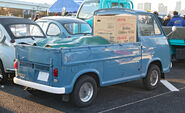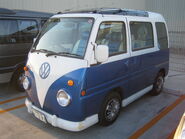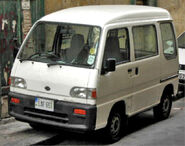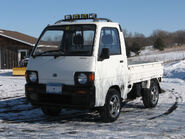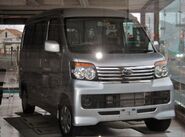(→1990-1998: Fixed errors -Sambars never ever came with intercoolers) |
m (cat) Tag: sourceedit |
||
| Line 98: | Line 98: | ||
[[Category:Rear wheel drive vehicles]] |
[[Category:Rear wheel drive vehicles]] |
||
[[Category:Pickup trucks]] |
[[Category:Pickup trucks]] |
||
| + | [[Category:Trucks built in Japan]] |
||
Revision as of 18:40, 12 June 2015

Subaru Sambar Dias
The Subaru Sambar is an automobile built by automaker Subaru for the Japanese market. It is Japan's first Keitora (軽トラ), shorthand for "kei class truck" and is still in production. The Sambar is available in both microvan and Kei truck (Pickup truck style) to fulfill the Kei car guidelines. Still popular in the domestic market, the Sambar continues to be produced in Japan, China, Korea, as well as in Finland with a joint venture with Elcat Automotive.
The name "Sambar" comes from a deer native to India commonly used to carry small loads.
Since its introduction, the Sambar has used a rear engine, rear wheel drive format (with optional 4WD from 1980 on), with the first two generations using the air-cooled engine from the Subaru 360, and later generations using the water cooled engine from the Subaru Rex, Vivio and the Pleo.
The current 2008 Subaru Sambar model is still using the Sixth Generation chassis and body with updated fascia. It was the first Kei truck in Japan that used a cabover design..
1961-1966
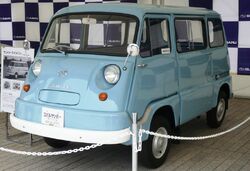
The first generation
(1961-1966)
From the very beginning in 1961, the Sambar uses 4-wheel independent suspension and a rear engine rear drive powertrain that helps keep the vehicles weight balanced. It was based on the Subaru 360 platform and it was introduced at the 1960 Tokyo Motor Show in both private purchase and commercial versions. The Chassis uses a ladder frame construction, using a torsion bar trailing arm suspension in the back. The reverse gearshift position was a left pattern selection, instead of a right pattern selection. The engine, called the EK series, was accessed from an access hatch inside the vehicle. The front doors opened in the same fashion as the 360, meaning the doors opened backwards, with the rear passenger doors opening conventionally, causing the hinges for all doors to be centrally located, with a rear hatch in back. Bunk beds could be installed as an option for outdoor camping use.
The Sambar was created for the market segment that desired a Subaru 360 that was able to carry small loads, such as for commercial delivery usage. The nickname for this version is the "kuchibiru" Sambar. 1961 saw competition in form of the front-engined Suzulight Carry which placed the engine in front of the driver but also adopted the cabover approach in 1966, and the Daihatsu Hijet cabover appeared in 1964.[1]
1966-1973

The second generation
(1966-1973)
The redesigned Sambar appeared in January 1966 with a fresh new appearance, with a truck version introduced. The nickname for this generation is "baban" Sambar.
The Sambar continued to use the 356 cc EK series engine, but now in the 20 hp iteration used in the Subaru 360 since July 1964.[2]
A raised roof for extended headroom was added to the options list in 1968. Starting with the 1970 model year, the engine was now accessed from outside the vehicle, and the front doors were conventionally hinged. To enhance safety a full padded dash pad was introduced, sharing the dashboard panel from the new R-2.
A styling upgrade was also done, adding a faux grille to the front of the vehicle that had no function other than a more modern appearance, as well as bringing the corporate look of the all new compact Subaru Leone.
The Sambar saw new competitors, the Mazda Porter in 1968, and the Honda Vamosin 1970.
1973-1982

The third generation (1973-1982)
(Subaru 700 export version)
The third generation appeared 10 February 1973, this one nicknamed the "Tsutomu Tsuyoshi" Sambar due to an advertising campaign at the time. The first series still carried a two-stroke two cylinder 356 cc engine but by now water cooled. The engine code was EK34, the truck received the K71 model code while the van was called K81.
As of February 1976, the engine was upgraded to the EK21 four-stroke water cooled version introduced in the Rex to reduce emissions. This model saw the introduction of an electric window washer pump to improve driver visibility. Because of regulations changes, only three months later the engine was again upgraded with a 490cc displacement (EK22 engine) for the Sambar 5 (K75 truck, K76 panel van, K85 van). This was in turn soon replaced by a full 550cc (EK23) model, the K77/87 of March 1977. In export, the Sambar was known as the Subaru 700, with a 665 cc version of the EK engine.
This model saw the introduction of a sliding side door added on both sides (although a version without the driver's side door remained available), with a full "B" pillar to enhance body stiffness instead of the approach used by the Nissan Prairie which had the front and rear doors interlock together. Minor horsepower improvements were introduced in 1977 along with an increase in the width of the vehicle. A sunroof was added to the options list in 1979. 4WD was introduced as an option in 1980, on both the van and truck bodystyles, conciding with the same feature being offered on the Subaru Rex.
1982-1990
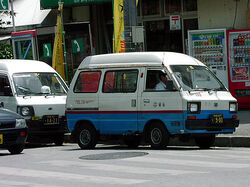
The fourth generation
(1982-1990)
May 9, 1982 is when the fourth generation model appeared (KR), also introducing the non-commercial Sambar Try (KT). The suspension was upgraded to a four-wheel independent layout with MacPherson struts for the front wheels. The wheel size increased from 10 inches to 12 inches, thereby accommodating larger drum brakes used at all four wheels. The 4WD was available with a dual-range transmission.
While the home market Sambar came equipped with the 544 cc, 2-cylinder 21 kW (29 PS) EK23 engine, export versions (known as Subaru 700) received an enlarged 665 cc version of the same, producing 23 kW (31 PS). LHD versions were available.
January 9, 1987 saw an extended roof feature available both with the Sambar Try trim level with the commercial version available with the standard height roof. An electric clutch was added to the options list as did disc brakes for the front wheels. Full time 4WD was available towards the end of this generations product cycle. In April 1989, a six-valve engine producing 25 kW (34 PS) joined the regular engine, itself downgraded to 28 PS. The EN05 four-cylinder engine used in the Rex was never fitted to the KR/KT Sambar, as it would require lots of reengineering to a soon to be replaced platform. The Domingo was available with the 3-cylinder EF10 1000cc engine starting in 1983.
A bigger version of the Sambar was available in Europe from 1983 with larger engines, the Sambar went by several names, such as the Subaru Sumo, Libero, (Japanese: Domingo) and Columbuss starting in 1983. The small-bodied version went by the name of Subaru 700 in the few markets where it was available.
The primary difference between the Sambar and the larger engined variants is the extension of both the front and rear bumpers to aid in occupant protection. The larger Domingo (and its various iterations) isn't considered "kei class" because the dimensions exceed the requirements and the engine displacement is larger than regulations allow.
1990-1998
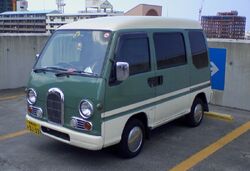
The fifth generation "Dias Classic"
(1990-1998)
The fifth generation Sambar was introduced in 1990. Engine regulations for displacement size were increased and the Sambar's engine was upgraded to 660cc. For the 4WD version it sold as Subaru Dias Wagon as a permanent trim model. Commercials in Japan used Kuniko Yamada.
The tradition of using the engine in Subaru's kei car offering, the Subaru Vivio's engine was shared in this version fo the Sambar, the EN07. The engines piston amount increased to four cylinders and 55 PS (54 bhp) was available with an optional supercharger, coupled with fuel injection. An automatic transmission was offered in the form of Subaru's ECVT system in tandem with full-time 4WD and a viscous coupling differential.
1994 saw a full model change with a body similar to the Domingo, with the EF12 three cylinder engine's displacement increased to 1200cc and SOHC borrowed from the Subaru Justy. A maximum seating capacity of seven was possible. October 1995 saw the elimination of the ECVT transmission due to drivability issues and a 3-speed automatic was available instead, coupled to the EMPi 46 PS (45 bhp) engine.
Special edition appearance packages were offered including a retro "Dias Classic", later available on the Sambar truck, influenced by the Subaru Vivio Bistro.
1998-2009

The sixth generation
(1999-2009)
The sixth generation was available for purchase May 2, 1999, and in 1998 kei class vehicle size regulations allowed for an increase in body size. The 4WD Dias is now only offered with a 3-speed automatic transmission, with the supercharger optioned engine power output increased to 58 PS (57 bhp). Carburetors are no longer used on the current version of the Subaru EN engine for the entire product line, and the EF engine is no longer manufactured.
On June 26, 2007 in the Japanese newspaper Nikkan Kogyo saw an article claiming that due to the investment by Toyota in Fuji Heavy Industries, the parent company of Subaru, that all kei class vehicles made by Subaru would end and be replaced by Toyota-owned Daihatsu models, rebadged as Subarus, which didn't go over well with traditional Subaru customers, especially loyal customers of the Sambar, the first microvan introduced in Japan. The Sambar's Daihatsu competitor is the Atrai and the Hijet. September 2009, the Sambar was replaced with the Subaru Dias Wagon, a re-badged version of the Daihatsu Atrai van.
July 18, 2008, items that were included were dual front passenger airbags, power sliding rear doors, power windows, and leather interior on upper trim level models.
References
| This page uses some content from Wikipedia. The original article was at Subaru Sambar. The list of authors can be seen in the page history. As with Tractor & Construction Plant Wiki, the text of Wikipedia is available under the Creative Commons by Attribution License and/or GNU Free Documentation License. Please check page history for when the original article was copied to Wikia |
- ↑ (2007) 360cc: Nippon 軽自動車 Memorial 1950-1975. Tokyo: Yaesu Publishing, 96. ISBN 978-4-86144-083-0.
- ↑ 360cc: Nippon 軽自動車 Memorial, p. 95
External links
- All Subaru Sambar models since 1961 (German language)
- Subaru Sambar Discussion Forum
- SUBARU-SAMBAR (Subaru Official Site in Japanese)
- Subaru Sambar Van Specifications from Kei Cars Canada
| Subaru, a division of Fuji Heavy Industries, vehicle timeline, 1990s–present | |||||||||||||||||||||
|---|---|---|---|---|---|---|---|---|---|---|---|---|---|---|---|---|---|---|---|---|---|
| Type | 1990s | 2000s | 2010s | ||||||||||||||||||
| 0 | 1 | 2 | 3 | 4 | 5 | 6 | 7 | 8 | 9 | 0 | 1 | 2 | 3 | 4 | 5 | 6 | 7 | 8 | 9 | 0 | |
| Kei car | Rex | Vivio | Pleo | Pleo | |||||||||||||||||
| R1 (RJ) | |||||||||||||||||||||
| R2 (RC) | Lucra | ||||||||||||||||||||
| Stella | |||||||||||||||||||||
| Microvan Kei truck |
Sambar / Domingo | Sambar | Dias Wagon (Daihatsu Atrai) | ||||||||||||||||||
| Subcompact | Justy KA | Justy GM M platform | Justy HT51S | Justy M310S | |||||||||||||||||
| Dex | |||||||||||||||||||||
| Compact | Leone/Loyale AC/AG/AN | Leone delivery van Y10 | Leone delivery van Y11 | ||||||||||||||||||
| Impreza GC/GF/GM | Impreza GD/GG | Impreza GE/GH/GR | |||||||||||||||||||
| Mid-size | Legacy BC/BF/BJ | Legacy BD/BG/BK | Legacy BE/BH | Legacy BL/BP | Legacy BM | ||||||||||||||||
| Sports coupé | XT AX | SVX CX | |||||||||||||||||||
| Compact MPV | Traviq GM T platform | Exiga YA | |||||||||||||||||||
| Crossover/SUV | Forester SF | Forester SG | Forester SH | ||||||||||||||||||
| Outback BG | Outback BH | Outback BP | Outback BR | ||||||||||||||||||
| Tribeca WX | |||||||||||||||||||||
| SUT | BRAT | Baja BT | |||||||||||||||||||
| Current | Dex · Exiga · Forester · Impreza · Legacy · Lucra · Outback · Pleo · R1 · Sambar · Stella · TransCare · Tribeca | ||||||||||||||||||||
| Engines | EA · EE · EF · EG · EJ · EK · EL · EN · EZ · AVCS · i-AVLS · FB | ||||||||||||||||||||
| Historic | 1500 · 360 · 1000 · Alcyone XT · Alcyone SVX · Baja · BRAT · FF-1 G · FF-1 Star · Justy · Leone · Sumo / Libero / Domingo / Columbuss (Europe) · R-2 · R2 (Modern) · Rex · Traviq · Vivio | ||||||||||||||||||||
| Concept | Subaru B11S · G4e · B5 TPH · B9 Scrambler · R1e | ||||||||||||||||||||
| Miscellaneous | Subaru.com • Subaru Global official site • Fuji Heavy Industries official site • Love. It's what's makes a Subaru, a Subaru. • Parent: Fuji Heavy Industries • | ||||||||||||||||||||
